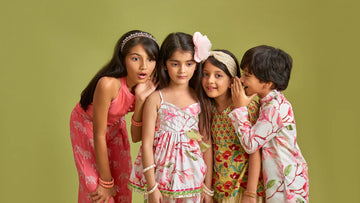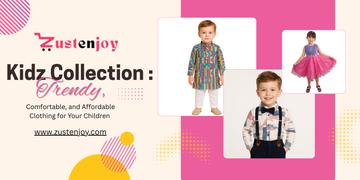Buying dresses for girls was easy in the old days—take something pink, put a bow on it, and voilà. But not today's kids and parents. They demand more than frills and flowers. Today's girls are confident, expressive, active, and trend-conscious. They need dresses that match their personalities, move with them, and make them stand out.
With online shopping, it has never been simpler to find the perfect dress for your niece, little sister, or daughter. With all these options available, however, how do you choose between dresses that are both stylish, comfortable, of good quality, and suitable for your child's age?
This resource takes you through what to search for when shopping for trendy girls' dresses online, how to create a wardrobe for each season, and what fabrics, fits, and details are most important. Whether you are dressing up for a birthday party, school event, holiday voyage, or simply daily errands, there is an ideal dress to be found online.
What Makes a "Trendy" Dress for Girls?
Trends in children's clothing change nearly as fast as in the adult world, but with one exception—children's clothes need to be functional and low-maintenance yet still stylish.
Popular Trends in Girls' Dresses
- Pastel and Earthy Colors: Lavender, peach, mustard, olive, and clay tones abound.
- A-Line and Smock Silhouettes: Comfortable, flattering, and airy.
- Statement Sleeves: Puffed sleeves, flutter sleeves, or ruffles.
- Layered and Tiered Skirts: Add whimsical volume without discomfort.
- Minimalistic Prints: Ditsy flowers, gingham, polka dots, and abstract prints.
- Sustainable Fabrics: Cottons, linen mixes, bamboo.
And don't forget about the value of pockets—a hot trend even on dresses for girls.
Types of Girls' Dresses for Various Occasions
1. Casual Dresses for Everyday
- Shirt dresses, T-shirt dresses, or jersey-knit dresses
- Made for school, playdates, and everyday wear
- Breathable, sturdy, and simple to wash
2. Party Dresses
- Features sequins, tulle layers, or satin accents
- Often has a formal touch—ideal for birthdays or family events
3. Festive or Ethnic Dresses
- Frocks with traditional embroidery, mirror work, or Indo-Western fusion
- Perfect for cultural events, weddings, or religious festivals
4. Summer Dresses
- Sleeveless cotton frocks, pinafores, and floral A-lines
- Designed to keep cool during hot weather
5. Winter Dresses
- Knitted dresses or woolen-blend styles
- Layered with tights, boots, and cardigans for warmth
Dress Features That Matter to Parents
- Fabric: Soft, airy, non-irritating fabrics such as cotton, jersey, or linen. Steer clear of fully synthetic ones except when dressing up.
- Fit: Always refer to size charts. Children grow rapidly, so going up a bit ensures longer wearability.
- Fastening: Prefer back or front buttons. Shun complex closures—dresses must be simple to wear and remove.
- Lining: Most necessary in party or netted dresses to avoid itching or see-through issues.
- Wash Care: Choose machine-washable products, unless it's an occasion dress.
How to Dress Up Girls' Dresses According to Season
Summer
- Sleeveless or short-sleeved cotton dresses
- Include a floppy hat and sandals
- Select light colors and light fabrics
Monsoon
- Quick-drying synthetic blends
- Printed dress shirts with rubber flip-flops
- Steer clear of long hemlines that are prone to getting dirty
Winter
- Fleece or wool long-sleeved dresses
- Throw in some warm leggings or tights
- Wear with boots and a beanie
Layering is your friend when it comes to wearing throughout the year. Buy neutral-colored sweaters, denim jackets, or cardigans to layer with existing dresses.
How to Select Age-Appropriate Dresses
For Babies (0–12 months)
- Onesie-style dresses or frocks with snap buttons
- Soft, tagless, stretchy cotton
- Simple designs, no sequins or beads
Toddlers (1–3 years)
- A-line dresses with back zippers or elastic waists
- Animals, prints, or character designs familiar to them
- Avoid anything with loose embellishments
Preschoolers (3–5 years)
- Twirlable dresses with bows or pockets
- Let them pick from 2–3 options
- Choose durable, wash-and-wear outfits
Primary School (6–10 years)
- T-shirt dresses, shirt dresses, or easy cotton maxis
- Playful colors or DIY solid options
- Show them how to coordinate shoes and hair bands
Enabling Self-Expression Through Fashion
Fashion can be an effective confidence builder for kids. When girls get to choose their dresses, convey their mood with colors, or test shapes, they learn about identity and choice.
- Provide limited but empowering options: "Do you prefer the purple or floral dress?"
- Discuss colors and how they affect them.
- Let them get it wrong occasionally—fashion is about individuality, not perfection.
- Add a range of frilly and sporty pieces—girls can do it all.
Sustainability in Girls' Fashion
While children grow out of garments fast, fashion does not have to be wasteful. Try these tips to make more informed choices:
- Purchase quality, not quantity
- Select brands that employ organic cotton or environmentally friendly dyes
- Hand down dresses to sisters or nieces
- Donate well-preserved dresses
- Repurpose old dresses into blouses or skirts
Conclusion
Online shopping has brought about the gateway of convenience, variety, and creativity in children's fashion. You no longer have to stick to local shops or plain designs. You can now shop online for trendy girls' dresses that not only look stunning but are also comfortable, well-fitted, and match every type of occasion or mood.
Whether your child is heading to school, a wedding, or a picnic, a thoughtfully chosen dress can make her feel confident, happy, and free to move. Take the time to explore styles, fabrics, and features that work for your child, and involve her in the process when possible.
When fashion meets comfort and individuality, dressing up becomes more than routine—it becomes a joyful expression of growing up.
FAQs: Girls' Dresses and E-Shopping
Q1. What is the ideal fabric for girls' dresses?
Cotton is ideal for casual wear. For celebrations, you can try satin, velvet, or chiffon—but ensure the inner lining is gentle.
Q2. How do I choose what size to buy online?
Always consult the brand's size chart and go one size larger if your child is near the maximum or growing rapidly.
Q3. Is online wear safe for sensitive skin?
Yes, provided that you opt for certified organic cotton or chemicals-free brands. Opt out of dresses with excessive embellishments or artificial linings.
Q4. How many dresses would I need to order for my daughter?
A minimal wardrobe can consist of 4–5 casual dresses, 2 party dresses, and 1–2 seasonal selections (such as winter dresses).
Q5. What if the size is incorrect? How do I exchange or return?
Most big portals such as FirstCry, Myntra, and H&M provide simple returns or size swaps within 7–15 days. Always look at the return policy while making an order.






